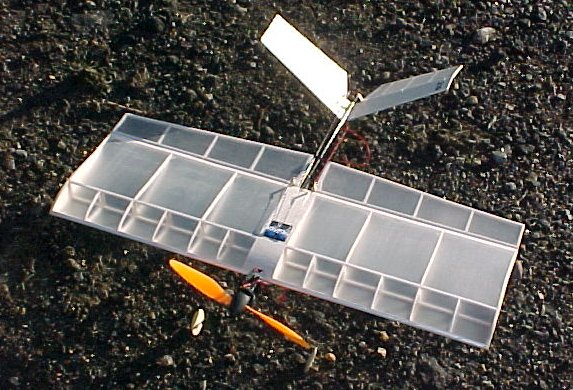

I found the plans of the 'Tiny' on the web while looking at micro R/C sites. The model was designed by Todd Long and is available as a kit from Todd's Models in the USA or Falcon Models in the UK. The plans can be downloaded from R/C Microflight magazine.
I was very taken by the 'V' tail. Reading the article accompanying the plans I was intrigued by the mixing system used. By using just two servos, this gives you both coupled ailerons and rudder and coupled elevators and flaps. A conventional tail is also shown.
The model was designed to use the DC1717 motor and 11.8:1 integral gearbox by WES -Technik. Further investigation showed that this is a 3 volt motor (although other windings are available), yet an 8 cell battery pack is specified for the Tiny!
I emailed Todd Long about this and he confirmed that the 3 volt motor was the correct one. I must admit that I almost scrapped the whole project when I found that the specified 9 x 5 carbon fibre prop cost almost as much as the already rather expensive motor/gearbox. I decided I could make my own prop and bought the power unit. More info on this can be found here.
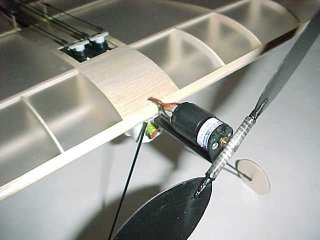
The design of the model uses several interesting techniques, like using heatshrink tubing to join piano wire ends to the carbon pushrods. However, the sizes specified simply didn't work for me. I increased the size from 0.5 mm dia to 1.0 mm and still needed to add a fairlead at the midway point to prevent flexing. Likewise the U/C which specifies 0.8 mm dia. I tried 1.0 mm but ended up with 1.5 mm just to support the weight of the model satisfactorily. This has proved to be excellent and has survived several really hard thumps.
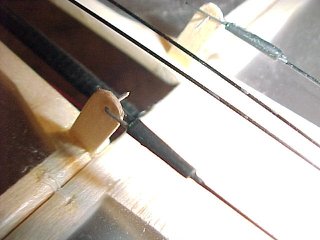
I acquired the specified 0.005" mylar for covering, but didn't really like the idea of a completely transparent (and highly glossy) aeroplane and it's effectiveness with my failing eyesight. Looking around I found some interesting alternatives available in the form of Supermarket carrier bags. In particular those used on the fruit counter of Tesco's! This is a translucent white with a satin finish, rather like lightweight silk. It is actually slightly lighter than the mylar and it's free.
This being my first experience of this type of covering, I wondered how to attach it. The usual advice is to use a glue stick. I used a Prit stick and found that this tended to dry out after a day or so and didn't retain it's grip. My solution was to allow an overlap of 1/8" or so all round and attach this with thinned Evostik (cellulose thinners). This is still holding. The material heatshrinks beautifully, but beware of using too much heat - it will burn holes.
With the specified motor/gearbox, a home-made 9 x 5 prop and 8 x 50 mAh nicad cells, the weight came to 4.25 ounces (120g). Slightly heavier than specified. And it refused to fly! On a smooth floor I had excellent taxying control, but no lift off.
Ever mindfull of the risk of overloading the motor, I bent more pitch into the prop and got a fairly short flight. The mixing system worked well and control was good. Cutting long stories short, I moved on to a GWS 9 x 7 prop and got reasonable flights of around 3 minutes. Cutting the prop down to 7" dia proved to be better and increased the flight time to 3 min 30 sec - but it wasn't even remotely aerobatic.
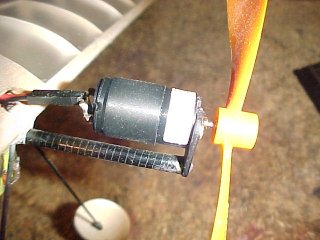
Now, the whole point of this model is that it is supposed to be aerobatic. Grossly overloading (and overvolting) the motor and shortening it's life is justifiable if we acheive the desired result. A pleasant sports model capable of short flights doesn't justify the means.
The solution proved to be very simple. Shorten the nose as much as possible and build up the carbon tube fuselage to suit a GWS 3.5:1 ratio IPS drive unit. Add a 6 cell 300 mAH NiMH battery pack and away we go. Weight is increased to 5 ounces (142g) and performance is excellent. Flight time depends on throttle usage, but I have managed 14 minutes plus indoors.
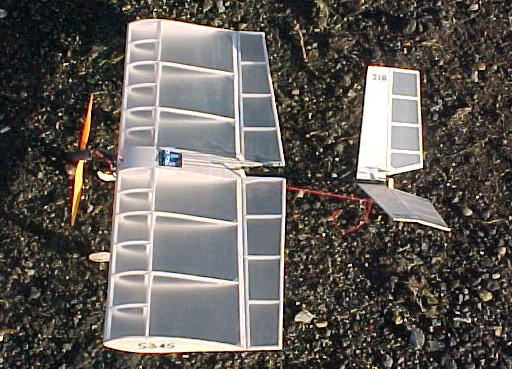
I've tried both of the specified GWS prop sizes for the drive unit; 7060 (7 x 6) and 8043 (8 x 4.3) and there is very little difference, although I have a slight preference for the 8 x 4.3.
Having the performance to perform aerobatics has shown up some interesting effects of that control system. Loops and bunts are fine. Rolls are strange. Application of down elevator as you pass through the inverted stage seems to kill the ailerons and the roll rate diminishes or stops. This is confirmed by inverted flight, where the ailerons almost don't work. I must try it without the coupled rudder sometime but it would probably be easier to build a new one with a conventional tail.
To anyone contemplating a 'Tiny', remember you can buy two GWS drive units and props for the price of one WES-Technik motor/gearbox.
